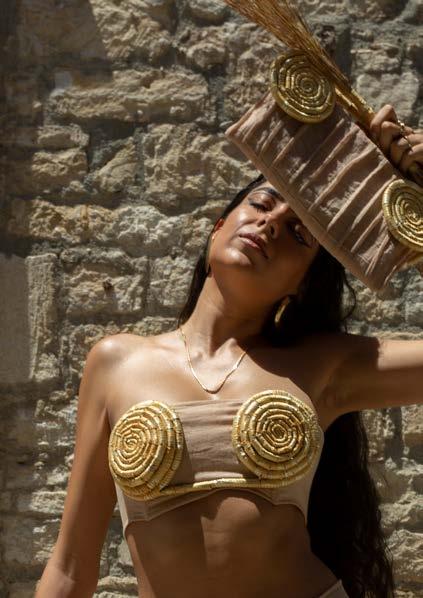
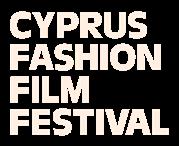
FHNC Fashion Show at CFFF Information booklet
Our Volunteers
Director & Head of Marketing
Creative Director
Fashion Sustainability Coordinator
HR & Well Being Advisor
Audio-visual Coordinator
Fashion Team Coordinator
Events Team Coordinator
Branding and Marketing Executive
Social Media Coordinator
Social Media Managers
Social Media Officers
Christina Dymioti
Andreas Guido Kontides
Marisa Satsia
Maria Christofi
Aimilia Sourmeli
Raphaella Themistokleous
Irene Panayi
Markos Charalambous
Lina Vafina
Margarita Charalambous
Katerina Christofi
Ariana Patsalou
Caterina Nikiforou
Simge Çelikden
Anastasia Mattheou
Andrea Kalou
Katerina Christofi
Graphic Design Coordinator
Graphic Designers
Senior Video Editor
Fashion Designers
Visual Artist
Heritage Officer & Interpretation Editor
Heritage Advisor
Event Assistant
Media Officer & Event Manager
Media PR & Coordination Officer
Creative Coordinator
Exhbition Curation Officers
Greek Speaking Translators
Heritage Advisor and Turkish Speaking Translator
Sergül Halil
Milan Theophilou-Woolley
Natali Touloupou
Sotiria Dymioti
İlkan Koral
Rengin Akcan
Valentina Koutsoudis
Antigone Papageorgiou
Kassandra Baker
Michalis Pantelidis
Anna Michaelidou
Anna Demetriou
Folkmona
Ariana Papadopoulou
Elin Yurtdaş
Thalis Chrysostomou
Mert Özyürekliler
Şüküfe Emirtaneoğlu
Salamis Ayşegül Şentuğ
Maria Averkiou
Yianna Sourmeli
Ekaterina Gobechia
Talia Songur
Danae Patsalou
Sotiria Dymioti
Lucy Hazrati
Sophia Raouna
Nikoleta Kyriaki Pourekkou
Azra Say-Ötün
Thank you to our Sponsors
We would like to express our heartfelt gratitude to the Municipality of Limassol and the Deputy Ministry of Culture for their gracious support in hosting this event.
We extend our appreciation to our official supporters: UNFICYP, Home For Corporation, Model Pro Agency, MAC Cosmetics, Fashion Revolution Cyprus, Deep Immersion, Digital Di and Starlit Screens, Shoebox, Kyperinos Winery, Recital Pro Sound Lighting and Event Gear, KEO beer, and CGA hair studio.
A special thank you to our media sponsors, RIK and LIFE.COM.CY, for their invaluable coverage.
Thank you all for making this event possible.
FHNC Socials
Facebook @fashionheritage.cy
Instagram @fashionheritage.cy
YouTube Fashion Heritage Network Cyprus
TikTok @fashionheritage.cy
LinkedIn Fashion Heritage Network Cyprus (FHNC)
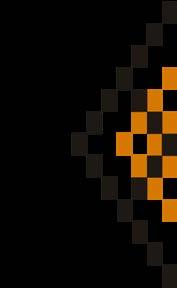
Fashion Heritage Network Cyprus (FHNC), the main partner of the inaugural Cyprus Fashion Film Festival, proudly showcases contemporary fashion designs that celebrate the dynamic intersection of sustainable fashion, art, architecture, and Cypriot cultural heritage. This exclusive event, hosted by Cult Experiences in collaboration with the FHNC, features the visionary work of 14 emerging Cypriot designers who are reimagining the island’s architectural legacy through eco–conscious fashion and celebrates their designs via Cyprus’s first bicommunal fashion show focusing on heritage and sustainability.
These designers draw inspiration from diverse eras of Cypriot architecture, from the ancient ruins of Salamis to Byzantine churches, from Lusignan church windows to Ottoman hammams, and even the detailed doors of modern Cypriot houses. The designers have transformed these architectural elements into stunning garments, utilising sustainable practices such as reuse, natural dyes, repair, and upcycling. The FHNC designers celebrate the richness and diversity of Cypriot architecture, showcasing its intricate details, unique materials, and cultural significance. Their designs aim to tell captivating stories of heritage, innovation, and the power of fashion to bridge the past and present. Each designer offers a fresh perspective on the island’s architectural landscape, exploring its influence on contemporary fashion and highlighting the importance of preserving this valuable heritage for future generations.
The festival fosters collaboration, dialogue, and awareness, showcasing the potential of sustainable fashion to transform the industry and contribute to a more conscious future.

Andreani Panayides (Folkmona)
Andreani (the founder of Folkmona brand) finds muse in the timeless Venetian bridges and arches that dot the island’s landscape, igniting her memories of family trekking along the Kalopanayiotis river, which usually ended at a grand Venetian bridge. Folkmona designs weave together cultural heritage with threads of Andreani’s personal memories. Sweeping arc designs, reminiscent of the bridges’ graceful curves, are incorporated throughout the collection. Rizari fabric, a unique Cypriot material, is used to accentuate these arcs, creating a captivating contrast against the natural linen base. The addition of a corset further highlights the curves, echoing the architectural inspiration. This choice not only reflects the design’s source but also
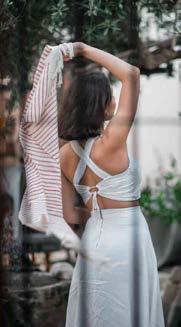
celebrates Cypriot craftsmanship and local, sustainable resources. Andreani’s commitment to cultural heritage extends to the very foundation of the collection. The use of 100% linen, traditionally produced in Cyprus, underscores a deep respect for the island’s legacy and a focus on eco–conscious practices. Each piece transcends mere clothing, becoming a narrative woven with threads of nostalgia and a dedication to preserving Cypriot identity for a sustainable future.
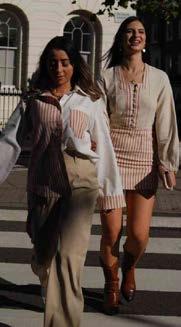
@folkmona
1
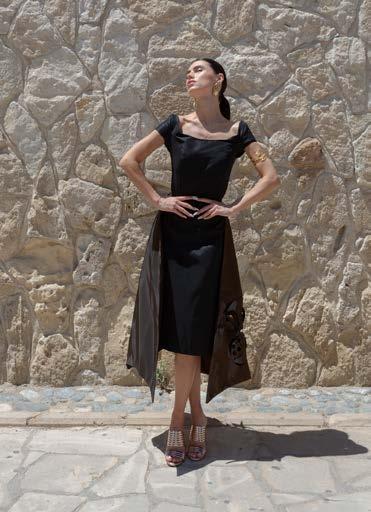
2
Anna Demetriou draws inspiration from the distinctive Gothic architecture of Famagusta, particularly the Cathedral of Saint Nicholas and Saint George of the Greek Orthodox Church. The designer, whose father is from Famagusta, reimagines these landmarks as garments that celebrate diverse elements of Cypriot identity and sustainable fashion. The first piece, a simple black dress, embodies the elegant, slender columns of the churches. A dramatic contrast emerges with a cape featuring a laser–cut window design, echoing the intricate tracery patterns of Saint Nicholas’ windows. The cape utilises a salt crystal technique, mimicking the way sunlight streams through the church’s large windows. The second dress transforms the ribbed
Anna Demetriou
vaulting of Saint George, a church that has endured centuries of change. By using structured “tumours” the designer aims to showcase the interplay between the strong geometric lines and elaborate details of Saint George of the Greek Orthodox Church. Both dresses reflect the churches’ hues with shades of brown, a nod to the natural stone from which they are built. The designs utilise reusable leather and sustainable fabrics, reflecting the designer’s commitment to eco–conscious fashion.

3 @anna_demtriou @annad_fashionline
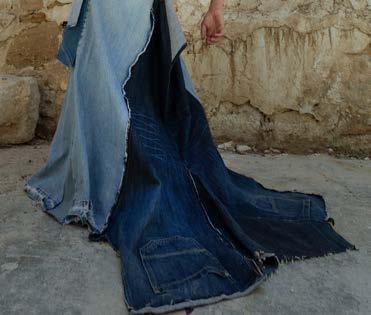
4
Anna Michaelidou (Yiavrimou)
Inspired by her mother’s migration and that of countless Cypriots, Anna’s garments weave together personal and collective histories. Each piece is a tangible exploration of lived experiences, memories, and aspirations, often anchored in the physical settings of old abandoned houses. The artist’s colour palette is drawn from the story’s setting: the turquoise of a shirt references weathered doors in Nicosia’s Old Town, while subdued tones allude to the sandstone of traditional Cypriot homes. Flowing fabrics mimic natural springs, hand–drawn cracks and embroidered beads capture the passage of time and individual stories, and photographs of Anna’s ancestral home in Kythrea act as windows to the past. Clothing becomes
a literal canvas for both physical space and memory to overlay, with each creation telling iterations of these stories. Upcycled denim, deconstructed and reimagined into innovative forms, echoes the transformation of old buildings into something new. Through her sustainable design philosophy and meticulous craftsmanship, Anna breathes new life into discarded materials and fading memories, inviting viewers to reflect on the enduring power of cultural heritage.
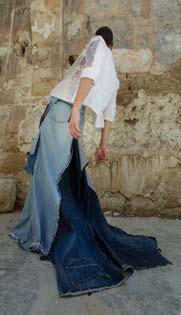
5 @yiavrimou_ @anna_michaelidou
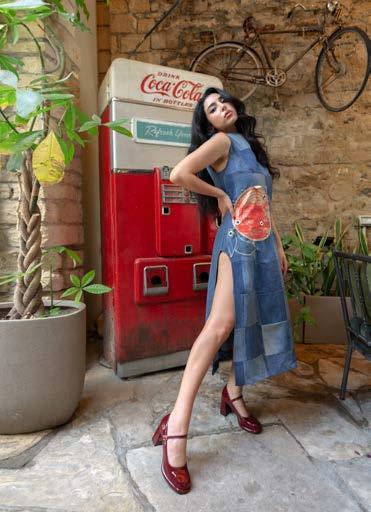
6
Domestic and sacral arches in churches inspire Antigone’s designs, drawn to their welcoming gesture and the evocation of emotions while passing through. The circular patterns on her garments merge two–dimensional images of traditional Cypriot tsesti/sesta (basketwork woven from dyed wheat stalks) with those of arches in the church of Agia Thekla in Famagusta, over a beige denim base. The resulting repetitive, centralising movements of the patterns, accentuated by eight eyes, concentrate around a central dark figure or a luminous eye, unsettling the viewer. Antigone’s design process involved meditating on emotional acceptance, the subconscious/conscious, memory, and the spiritual experience of entering churches. Inspired by Cypriot
Antigone Papageorgiou
engraver Hambis Tsangaris’ book «Οι
(The goblins and the game) and Carl Jung’s method of active imagination, she interacted with her grandmother in her imagination, a scene set among the arches in her home. The imaginary, according to Antigone and Tsangaris, is as real as reality itself, and not something to fear but to reckon with. Antigone finds that Cypriot faith and the practice of visiting the church can be a strong medium of exploring our internal world. The denim used in the garments belonged to the artist, her brothers, and her friends, and was sustainably repurposed from existing fabric.
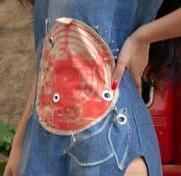
καλικάντζαροι τζαι το παιξίμιν»
7 @eightisforthetry
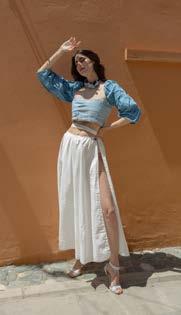
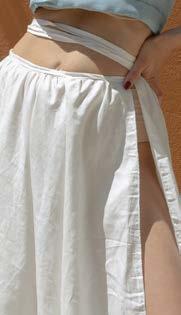
8
Ariana Papadopoulou (Akanthas)
Ariana’s collection draws inspiration from the striking Del Mar building in Limassol, a testament to modern architecture’s harmonious relationship with its surrounding topography. The building’s graceful curves and fluid lines, reminiscent of ocean waves and billowing sails, are reimagined in the flowing silhouettes and fabric manipulations of these garments. Marrying modern design with traditional Cypriot elements, the designer incorporates vintage lace reminiscent of Lefkaritika, a delicate embroidery technique, adding a touch of cultural heritage to the contemporary
aesthetic. The colour palette, dominated by blues and whites, evokes the natural beauty of Cyprus, the sea, and the sky. The structured corset, tailored skirt/ trousers, voluminous raglan sleeves, and airy chiffon fabric all contribute to a dynamic interplay of form and texture. Through this collection, the designer celebrates the fusion of architectural innovation and traditional craftsmanship, showcasing the timeless allure of Cypriot aesthetics in a modern context.
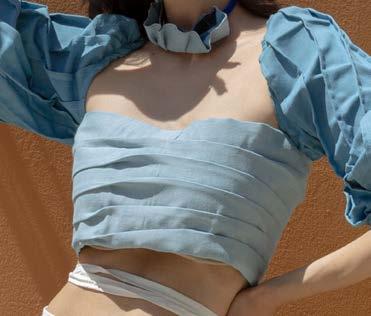
9 @ariana_papa @akanthas_
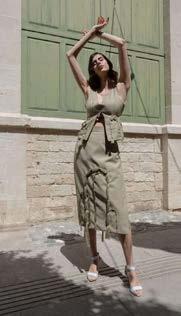
10
Elin Yurtdas
Elin has long been mesmerised by Cypriot architecture, particularly the iconic arches. These architectural details have permeated her artistic work in various forms, inspiring ceramic sculptures, sketches, and paintings. This collection marks a natural appreciation of arches in Cypriot architecture, translating the inspiration into wearable art with a sustainable approach. Beige cotton canvas, indicative of the neutral tones found in Elin’s mother’s çeyiz (Cypriot dowry chest), becomes the foundation for each piece. Layered upon this base are rich textures created with threads in shades of green, sage, and brown, inspired by olive trees, echoing the traditional Lefkara embroidery patterns often found on these treasured textiles. These layered
threads build upon each other, forming graceful arches that pay homage to the architectural heritage of Cyprus. The use of natural fibres – cotton canvas and thread – emphasises the designer’s commitment to eco–conscious fashion. The inclusion of terracotta pieces, inspired by the designer’s artistic endeavour in ceramics, adds a unique touch and further connects the collection to Cypriot culture. Apart from the pattern of the 2–piece set, the threads forming arches are the most eye–catching element, as exaggerated proportions and threads exceeding the fabric may create movement and a little chaos while walking. Elin’s designs aim to capture the dynamic nature of architectural elements, infusing the garments with a sense of life and energy.
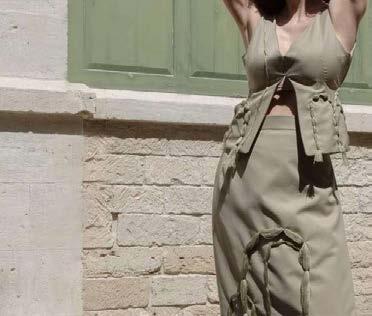
11 @elinyurtdas
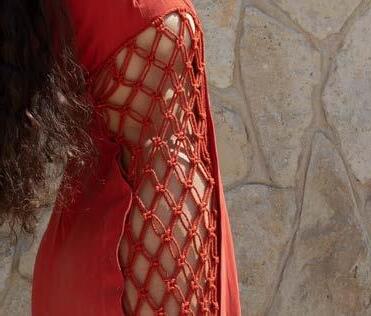
12
Ilkan’s collection is inspired by the architectural beauty of ancient Cypriot hammams, their signature domes and roofs, symbolising perfection, unity, and the eternal cycle of life, which deeply resonate with the designer. Ilkan honours this heritage through designs that blur the lines between past, present, and future. Ilkan’s grandmother’s stories paint a vivid picture of the hammam as a haven for women. The sense of sisterhood, freedom, innocence, and shared care that infused these spaces echoes within Ilkan – an inherited connection to both place and way of being. The collection embraces a natural aesthetic with exclusively natural fibres, mirroring the essence of its inspiration. Fabrics flow with a sense of fluidity, while circular forms and curves echo the domes and
light–filled spaces of hammam architecture. Macramé, an ancient textile technique symbolising family and unity, takes centre stage. Delicate, exaggerated side panels showcase intricate macramé work, highlighting the beauty of artisan craftsmanship. Large, bold circles and curves dominate the collection, creating a striking visual impact that pays homage to the grand scale of the hammam. This emphasis on shape speaks to a sense of naivety, fluidity, and the influence of Mesaourian women. “Allongé,” a term borrowed from ballet, meaning elongated, perfectly encapsulates Ilkan’s current state of identification. It represents a position of nuance and refinement, branching out and finding connections within oneself and the continuous process of realisation.
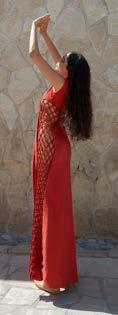

Ilkan Koral
13 @ilkantim
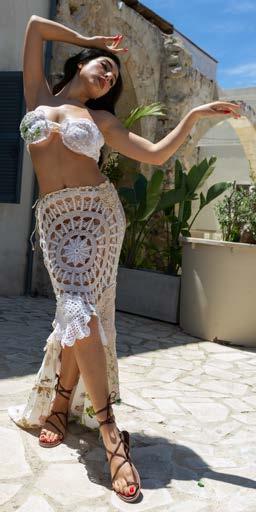
14
Kassandra’s work is an exploration of heritage, nature, and the passage of time, all woven together through the intricate motifs of Lefkara lace and the wrought–iron gates of Katholiki, Limassol. Recognising the recurring patterns that imbue both metalwork and textiles with a distinct Cypriot identity, Kassandra honours this legacy by placing lace at the heart of her designs. Inspired by the delicate doilies reminiscent of Lefkaritika, traditionally cherished within the intimacy of Cypriot homes, she seamlessly integrates this intricate craft into her contemporary creations. Nature’s touch is also evident, as embroidered vines intertwine with the lace, symbolising the passage of time and the spirit of life that embraces and transforms even the most rigid
Kassandra Baker
structures. Building upon her previous FHNC piece on the theme of nature, Kassandra’s work continues to explore the harmonious interplay between the internal and external worlds. Kassandra infuses her creations with a modern sensibility while remaining deeply rooted in tradition. As a half–English Cypriot, Kassandra’s personal experiences of both connection and exclusion inform her artistic journey. Although she often finds the gates of family in Cyprus closed in her experience as a half–English Cypriot, her work is an exploration of integration and connection, as well as the softening of boundaries between metal, textiles, and life.
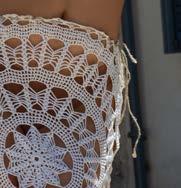
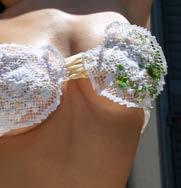
15 @kassandroua

16
Drawing inspiration from the transformative history of structures, Mert’s collection celebrates the power of architectural adaptation and the unifying spirit of shared spaces. One of the garments is inspired by the facades of buildings, and the second design, inspired by the St. Nicholas Church in Famagusta, which symbolises the unity of Cypriots, transcending religious differences. The church’s transformation from a Gothic structure to a mosque represents a melting pot of diverse backgrounds. Mert skilfully incorporates elements from both architectural styles, as well as religious objects like the Taqiyah, the skullcap worn by Muslim men. These designs showcase the coexistence of different religions within the same structure, emphasising the shared intention of prayer. To maintain a focus on sustainability,
Mert Ozyurekliler (Shirvanna)
Mert incorporates thrifted old Cypriot curtains and utilises textured canvas fabric combined with mesh fabric, adding depth and visual interest. This collection represents Mert’s journey of rediscovering what it means to be Cypriot, beyond the narratives imposed by history books and politicians. It is an opportunity to honour the diverse heritage and ancestral connections that shape their identity. Inspired by the stones used in the construction of these architectural marvels, earthy tones and browns are integrated into the designs. The incorporation of clear plastic vinyl fabric reminiscent of the windows found in these structures adds a touch of authenticity. Larger sculptural shapes and dramatic silhouettes are used to reimagine architectural grandeur.
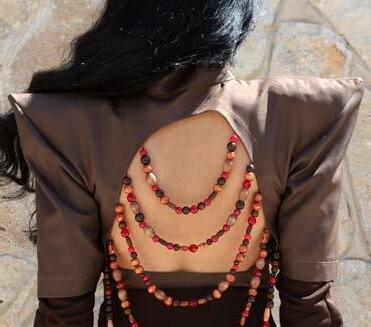
17 @shirvanna @mert_ozyurekliler
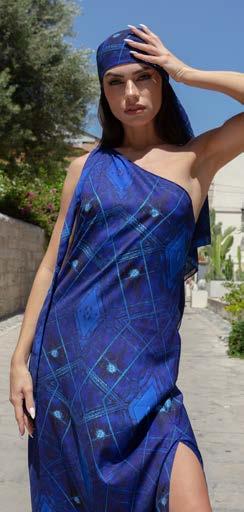
18
The open door is a symbol of hospitality in Cyprus, a theme that resonates throughout Michalis’ work. For this piece, the artist draws inspiration from two distinctive doors found in the Old Town of Lefkosia: a wooden door adorned with flowers–in–vase motif, and a blue wrought–iron door. Michalis’ kaftan designs seamlessly blend these two doors in a digital collage printed onto chiffon made from recycled plastic. Typical designs in Cyprus are flat or diamond–shape chamfered panels (a carpentry technique that creates a slightly sloping edge between two surfaces) framed by ornate cornices. But the flowers on this door, reminiscent of floral designs on wooden furniture carvings, might be assigned to only a handful of craftsmen at the turn of the 20th
Michalis Pantelidis (Michalis Pantelides Studio)
century. One of these was Süleyman Arifoğlu, who trained at the Royal Sultan’s woodworking academy in İzmir around 1910, and worked in Limassol. The simple silhouette of the garment emphasises the intricate details of the print, highlighting the smooth texture of the woodcarving, the vibrant blue of the metal door, and the heat–hammered curves. By spotlighting the artistry and craftsmanship behind these ornate doors, Michalis celebrate their importance in Cypriot architecture and social life. “The outside was as important as the inside,” he says, which is even more apparent in the warmth of summer when domestic life in Cyprus turns outwards, and doors open to invite a breeze.
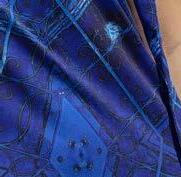
19
@michalispantelidistudio @michalis_pantelidis

20
The grandeur of Ionic columns and their significance in Cypriot architecture inspired Rengin to create this collection, which showcases her exploration of the powerful aesthetic of the Ionic order, translating it into unique and captivating fashion pieces. Rengin’s designs pay homage to the preserved historical sites and the historical significance they hold. With the exception of the beachwear, which necessitates the use of synthetic materials, the designer primarily uses natural fabrics. Additionally, Rengin adheres to a no–waste policy in creating each design, reflecting her commitment to sustainability. The colour palette embraces natural tones, evoking a sense of harmony with the surrounding environment. Rengin’s first outfit showcases a top made
Rengin Akcan (RA Studios)
from straws, reminiscent of the way sestas (traditional Cypriot straw mats) are crafted. Collaborating with a local artisan experienced in the art of sesta–making, Rengin’s creation showcases the fusion of traditional craftsmanship with contemporary fashion. This unique choice of material adds a touch of authenticity and cultural significance to the design. Through this collection, Rengin demonstrates a deep understanding of the island’s rich history, embracing the memories left by the diverse cultures that have inhabited Cyprus.
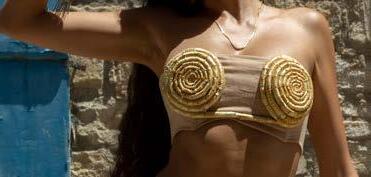
21 @rastudiocy @ra821
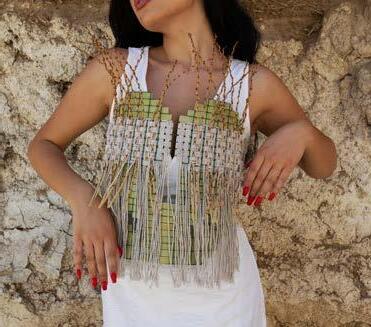
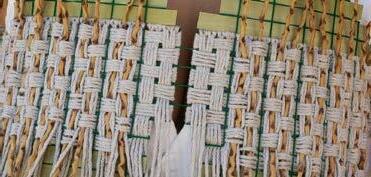
22
Şukufe’s main inspiration is vernacular architecture, constructed using local, traditional materials and reflecting the unique features of a particular region. In Cyprus, many such buildings are adobe (kerpiç ev/ πλιθάρενο or πλιθαρόχτιστο ), a sustainable building material made of mud and straw. While its use has declined over the years, Şukufe, who has worked on their restoration and lived in an adobe village, seeks to highlight their eco–friendly and cost–effective qualities. The layered texture of age–old adobe houses informs her textile designs. She has chosen linen as her base material for its resemblance to the plaster used to renew a crackling adobe wall, its natural origin, and its earthy colour. Her garments are further adorned with a
Şüküfe Emirtaneoğlu
woven combination of wires, wool, handpicked plants like palm and wheat branches, and fabrics inherited from her grandmother. As an architect, Şukufe brings a keen eye for visual balance to her textile creations. The half–linen, half–corset design gives equal attention to both architectural and woven elements. Like beams supporting a roof, date branches act as a focal point and reinforce the corset structure. Şukufe weaves together memory, craftsmanship, adobe constructions, and natural materials to create unique, eco–conscious wearable pieces. Her work is a testament to the enduring beauty and potential of traditional building techniques in a modern, sustainable context.
23 @sukufefloralprojects

24
The Church of St. Lazarus, an important Byzantine monument in Larnaca and a testament to centuries of transformation and resilience, holds deep personal significance for Thalis. It is imbued with the mysticism of his hometown, echoes of his parents’ wedding, and the rhythm of Easter ceremonies. Recognising the diverse cultural influences woven into the church’s architecture–Latinate, Gothic, and Baroque elements–Thalis finds a reflection of his own multifaceted identity. Inspired by the bell tower’s bold stature and ornate embellishments, he adopts a neutral colour palette as a humble base, echoing the earthy limestone.
Thalis Chrysostomou
Bold colours, patterns, and patchwork then create a striking visual impact. The ancient decorations are reimagined as woven motifs and lace, while columns, arches, and their shadows transform into dramatic pleats, infusing the garments with depth and mystery. Minimal lines, triangular panels, and overlays echo the church’s dramatic silhouette, providing structure and contrast to softer elements. These softer elements–the pastel hues of the sunset sky, the flourishing plants, and the creatures of the courtyard–find expression in shimmering taffeta and verdant tones, while leather panelling adds a touch of organic texture.
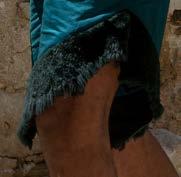
25 @thalis_chrysostomou @thalischrysostomou_
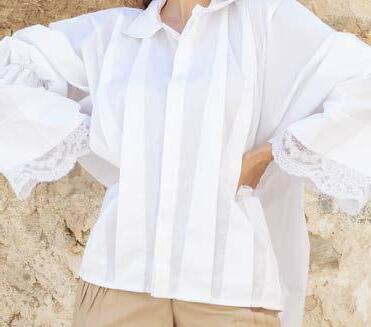
26
Valentina Koutsoudis (Koutskouture)
Valentina’s work is a love letter to Lefkara, her ancestral village on the southern Troodos slopes, famed for its white silica and limestone architecture and delicate Lefkaritika lace. Drawing inspiration from her grandmother’s home–the site of her parents’ traditional wedding and countless childhood memories–Valentina infuses her designs with the warmth and essence of Cypriot heritage. Her first look, a pleated shirt and trousers ensemble, evokes the interplay of light and shadow on the village’s window shutters and metal balconies. The oversized silhouettes and repetitive lines mirror the architectural patterns of Lefkara. The second look, a quilted puffer dress, pays homage to the textures and shapes of the island’s calcareous
stones. Adorned with free–hand embroidery and elements of Lefkaritika, the dress echoes the disorganised texture of stone walls. As a Cypriot and a convert to Islam, Valentina’s work explores the intersection of faith, heritage, and community. Her designs empower through modest fashion, fusing traditional crafts like Lefkaritika with head coverings and restrained silhouettes. Committed to sustainability, she utilises existing fabrics, upcycles textiles, and incorporates natural materials like avocado buttons.
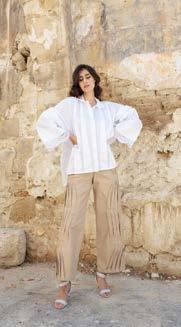
27 @koutskouture
28








































